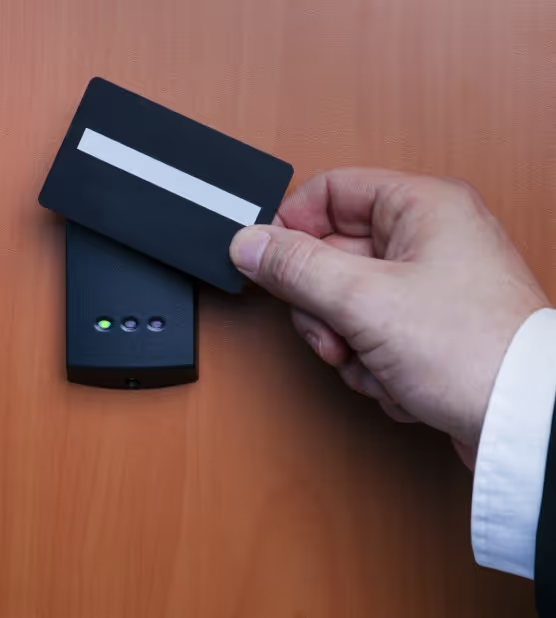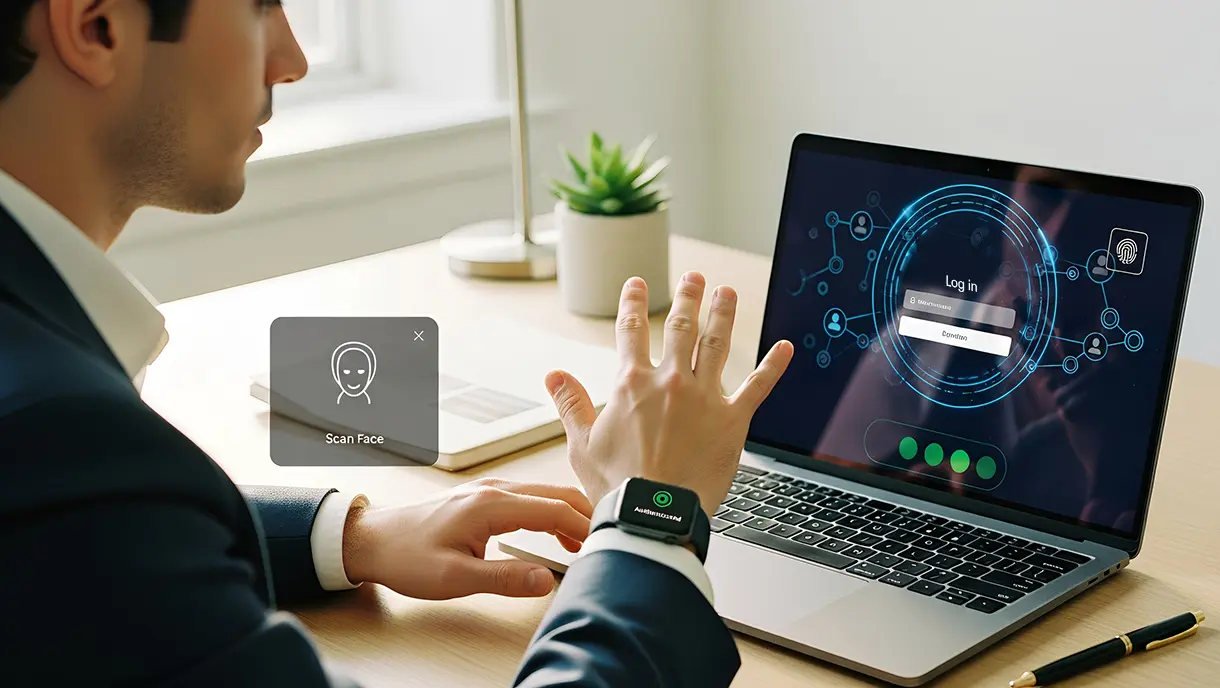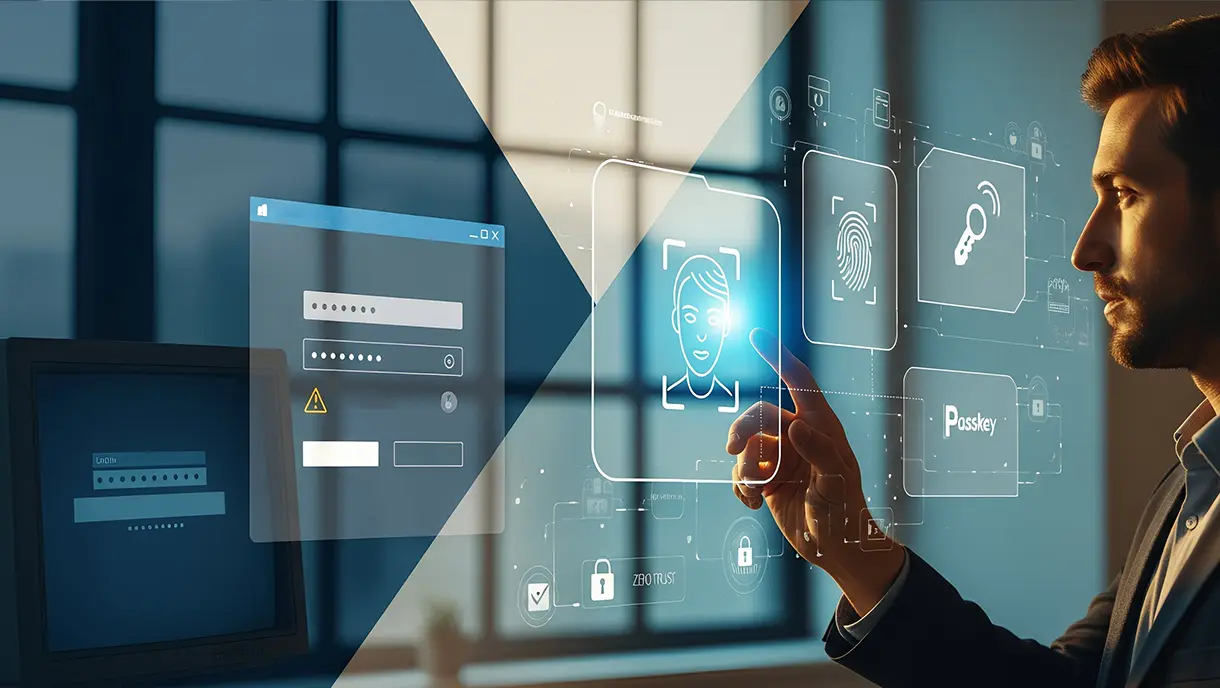How do RFID cards work?
This guide explains what RFID cards are and how they function as contactless tools for secure identification and access. It covers the working principles of RFID cards, their benefits over traditional password-based systems, and common real-world applications across industries. Learn how to choose the right RFID card solution, compare them with mobile access, and explore their role in enhancing security and efficiency.

RFID cards, or Radio-Frequency Identification cards, are used for tracking and identifying objects wirelessly. They consist of a small chip and antenna embedded in a plastic card, similar in size and shape to a credit card. The chip stores information that can be read by an RFID reader, which sends out a radio frequency signal to activate the chip.
One of the main advantages of RFID cards is that they allow for contactless communication between the card and the reader. This means that the card does not need to be physically inserted into a reader or scanned, making the process of tracking and identifying objects much more efficient. RFID cards are often used for access control, time and attendance tracking, and inventory management.
Let’s explore how RFID cards work and why they are a safer option for access control as compared to password or PIN systems.
What are RFID cards?
RFID cards are physical access cards that use radio frequency identification to grant access to a particular area or individual. They work by emitting a signal that can be detected by an RFID reader, granting access to the cardholder.
RFID cards are a more secure alternative to traditional passwords, as they are difficult to replicate and do not require manual input. This makes them ideal for physical access and identity management applications, where security is paramount.
"The future is about the Internet of Things, and RFID is a key technology that will enable it. It will allow us to connect the physical world to the digital world in new and innovative ways."
How does an RFID card work?
RFID cards work by emitting a radio signal that a scanner can read. The scanner emits a signal that the card receives, which then responds by transmitting the information stored on the card. This process allows the card to be read without having to be physically touched by the scanner.
There are two main ways an RFID card can be used: passive and active.
- A passive RFID card doesn’t have a battery, so it relies on the reader to provide power. This card type is generally used for access control.
- An active RFID has a battery to broadcast a signal farther away from the reader. This card type is often used for tracking, such as supply chain management or asset tracking.
Benefits of using RFID Cards
There are several benefits to using RFID cards instead of passwords.
First, RFID cards are more secure than passwords. They’re harder to hack and can’t be guessed or stolen like passwords. RFID cards emit a unique signal that authorized readers can only read.
Second, RFID cards are more convenient than passwords. They don’t require special memorization and are always with you whenever you need them. You can bring them closer to the reader to unlock doors or access your account. (Also Read : Mechanics of Passwordless Authentication )
Lastly, RFID cards are more efficient than passwords. They reduce the time it takes to get through security checkpoints, and they eliminate the need to fumble with passwords in busy environments.
Common applications of RFID Cards
RFID cards are used in various ways to keep people and data secure. RFID cards are often used as access control cards in many businesses, providing a quick means for employees to access their workspaces without having to remember or type in passwords.
RFID cards can also be used as payment cards by embedding embedded chips allowing them to work with point-of-sale (POS) systems. These cards allow customers a fast and convenient way to pay for goods and services without manually entering any information.
Lastly, they are also commonly used in hospitals or other healthcare facilities, known as smartcards containing patient information that can be accessed by both physicians and nurses quickly and easily.
Here’s a table outlining common applications of RFID cards across various industries:
How to select the right RFID card solution
When selecting the right RFID card solutions for your business, there are many things to remember.
First and foremost, as with all things related to physical access and identity management, you should always opt for solutions that meet the highest security standards.
Next, consider how these cards will be used within your organization. Will staff use them for access control purposes, or do you need an all-in-one solution that provides access control and time tracking capabilities?
Finally, the cost is something to look into as well. While RFID cards can be relatively inexpensive in the short term, they do come with a certain degree of recurring costs—including card replacements, data storage, and maintenance fees.
Selecting the right RFID card solution for your business involves careful consideration of various factors. Here’s a table outlining key factors to help you make an informed decision:
Key Factors for selecting the right RFID Card Solution for your business.
For those who may be new to using RFID cards, there are a few questions to consider.
How secure are RFID cards?
First, know that these cards are highly secure. They’re encrypted, using strong encryption algorithms to protect data stored on the card. Also, they’re more difficult to clone than traditional magnetic strip cards.
Will my RFID card work with an access control system?
Second, when it comes to compatibility with your access control system or other physical access control solutions, you should always ensure that your solution is RFID-compatible before investing in any hardware or software solutions. It’s always best not only for compatibility but also for long-term cost savings as well.
RFID Cards vs Mobile Access: Which is better?
RFID cards and mobile access are both technologies used to grant access to physical locations or resources. RFID cards, or radio frequency identification cards, use radio waves to communicate with a reader, allowing the user to gain access by simply holding the card near the reader. On the other hand, mobile access uses a smartphone or other mobile device as the means of access. The user typically has to open an app or use a QR code to gain access.
One of the main benefits of RFID cards is their simplicity. They are easy to use, as the user only needs to hold the card near the reader, and they don’t require any manual input. This makes them ideal for environments where speed and convenience are important, such as security checkpoints or time and attendance tracking.
Mobile access, on the other hand, offers more flexibility and convenience. With mobile access, the user always has the means of access with them, as long as they have their mobile device. It also offers the possibility for more advanced features, such as push notifications or location-based access control.( Also Read: Mobile Access Control is future of Access Control)
Comparison table between RFID cards and mobile access for various factors.
When it comes to security, both RFID cards and mobile access have their strengths and weaknesses. The choice between RFID cards and mobile access will depend on the specific needs of your organization. If speed and convenience are important, RFID cards may be the best choice. On the other hand, if flexibility and advanced features are a priority, mobile access may be the better option.
Lastly, if you consider implementing RFID cards in your security system? While they offer numerous advantages, it's crucial to ensure proper implementation for optimal effectiveness. Explore alternative contactless technologies like NFC and BLE in our informative blog post: 'RFID Vs NFC Vs BLE: Which is Better Suited technology for your Business?' Gain valuable insights to make an informed decision for your specific needs!
Conclusion
For these and other reasons, RFID cards are becoming more common in workplaces and other settings where security is a concern. However, as with any new technology, there are some things to consider before implementing RFID cards in your security protocol.
Chief among these is the need to manage access privileges carefully. RFID cards can be easily stolen or counterfeited, so it’s important to keep track of who has access to what areas and when. In addition, you’ll need to ensure that the card reader infrastructure is configured correctly and that employees know the proper procedures for using RFID cards.
With proper planning and execution, RFID cards can effectively and conveniently improve security in your workplace or other settings.
FAQs
1. How do RFID cards work?
RFID cards use radio signals to wirelessly transmit data from a chip to a reader, enabling contactless tracking and identification.
2. What are RFID cards?
RFID cards are physical access cards emitting signals for access control, providing a secure and convenient alternative to passwords.
3. How does an RFID card function?
An RFID card responds to a reader’s signal by transmitting stored data. Passive cards rely on the reader’s power, while active cards have a battery for broader range.
4. What are the benefits of RFID cards?
RFID cards offer heightened security, convenience, and efficiency compared to passwords. They find use in access control, payments, healthcare, and more.
5. Can contactless cards be skimmed?
While traditional skimming targets magnetic strips, contactless cards (like RFID) use encrypted data and short-range communication, making them generally resistant to skimming. However, staying vigilant and reporting suspicious activity is still crucial.
6. How much do RFID tags cost?
RFID tag costs vary greatly based on type, memory, and features, ranging from a few cents to several dollars each.
7. How does RFID blocking work?
RFID blocking wallets or sleeves incorporate materials that attenuate radio waves, preventing scanners from reading the chip data inside your cards.
Get the latest updates! Subscribe now!








